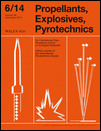Mach Wave Control in Explosively Formed Projectile Warhead
Abstract
A Mach wave emerges at the top of the liner when a wave shaper is embedded in charge, and thus seriously breaks the explosively formed projectile (EFP) nose. Thus, to avoid breakage at the EFP nose, the pressure behind the Mach wave should be controlled. An analytical model for calculating Mach wave parameters is presented based on three-shock theory. The parameters of Mach waves, such as their growth angles and radii, their velocity along the plane of symmetry, and the pressure behind them, can be determined. Calculation results show that when the diameter of the wave shaper is reduced or the distance between the wave shaper and liner increases, the incident angle of the detonation wave at the top of the liner increases and thereby lowers the pressure behind the Mach wave. Avoiding the occurrence of Mach waves by reducing the incident angle fails to avoid breakage at the nose of the EFP, but lowering the pressure behind the Mach wave by increasing the incident angle avoids breakage at the nose of the EFP. Calculation and simulation results are validated through X-ray imaging experimentation.




